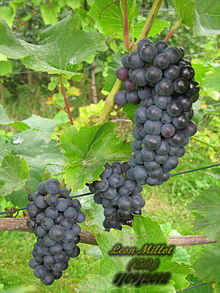Leon Millot
| Léon Millot | |
|---|---|
| Grape (Vitis) | |
 |
|
| Color of berry skin | Noir |
| Species | (Vitis riparia × Vitis rupestris) × Vitis vinifera |
| Also called | see below |
| Origin | France |
Léon Millot (sometimes called "Leon Millot Rouge" (or "Foster's Leon") to distinguish it from "Leon Millot Noir" (a.k.a. "Wagner's Leon") which many breeders believe to be Oberlin 595) is a red variety of hybrid grape used for wine. It was created in 1911 in the Oberlin Institute in Colmar, Alsace, by the French viticulturist Eugène Kuhlmann (1858–1932) by crossing the hybrid grape Millardet et Grasset 101-14 O.P. (which is Vitis riparia × Vitis rupestris) with Goldriesling, which is Vitis vinifera. The variety was named after the winemaker and tree nursery owner Léon Millot.
Grape characteristics: Léon Millot ripens early, is blue-skinned, grows with fair vigor, and has high resistance against fungal diseases. It is therefore suited for cultivation in cooler climates. The grape has small berries and small clusters (perhaps 0.20 lbs/cluster), and thus it is time-consuming to manually harvest. It can yield a bigger wine similar to a ripe Syrah, or a lighter wine more in the style of Pinot Noir. Common aromatic and flavor profiles for Leon Millot include earthy/barnyard/woodsy notes, purple fruits, and chocolate.
Winemaking with Leon Millot: Some winemakers believe that if left on the skins too long, Leon Millot can develop unwanted herbaceous notes from its Vitis riparia background. Also, the grape is high in malic acid and a malolactic fermentation is usually necessary (this should be begun no earlier than Specific Gravity = 1040, and may be delayed to a month or so after primary fermentation; some winemakers believe that delaying the MLF allows more time for the added tannins to fix the color). A malic-reducing yeast might also be used to good effect. As the grape is low in tannin, a tannin addition during fermentation is often useful, and that may also help to prevent color loss. If Leon Millot is allowed to remain too long at higher pH levels, its deep, vivid purple color can change to red or brick red. Some winemakers believe that Leon Millot should be harvested at no higher than pH 3.2 for this reason. Also, take care to reduce the pH quickly after malo-lactic fermentation, if the pH rises too high (a rise to approximately pH 4.0 is not unusual, and can lead to color loss). Better examples of Leon Millot wine have won significant awards, and many wine lovers believe they can rival the better vinifera wines. But, as with all modern varieties of grapes ("hybrid" grapes), it takes work in the winery to realize the grape's full potential.
...
Wikipedia
